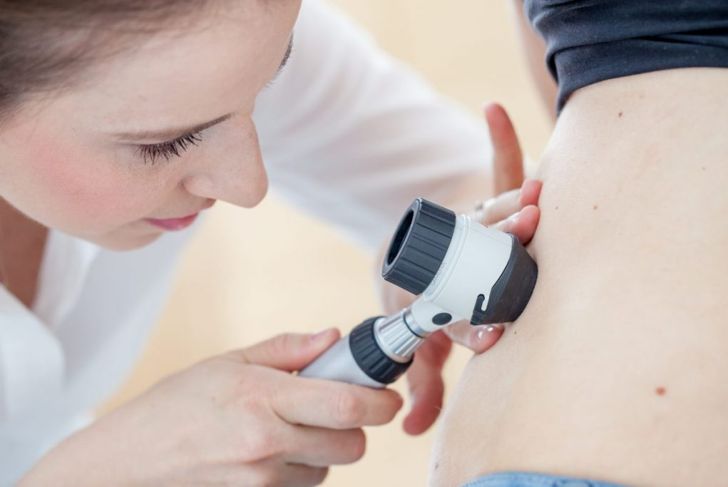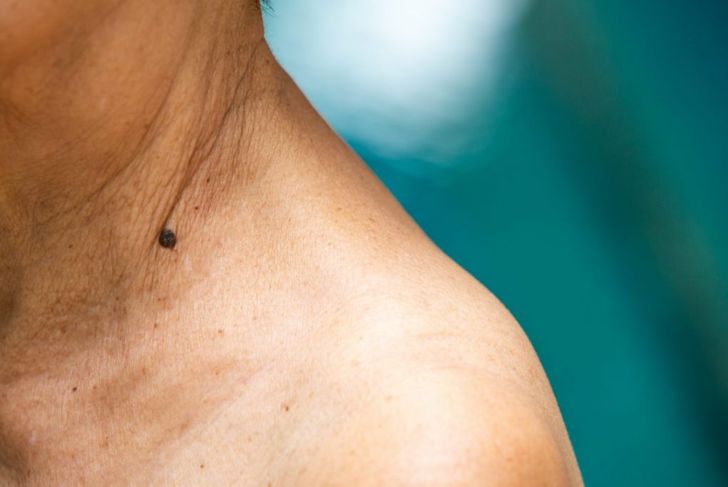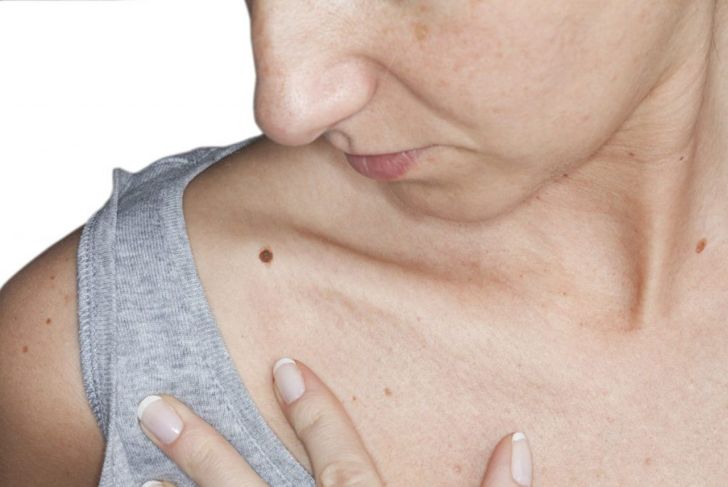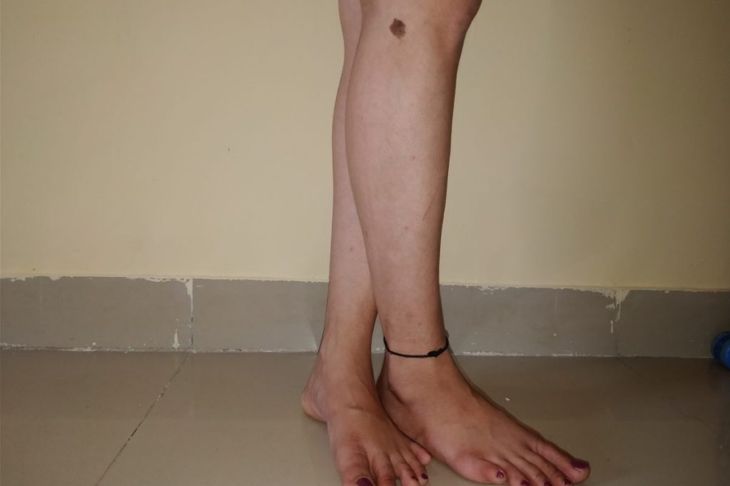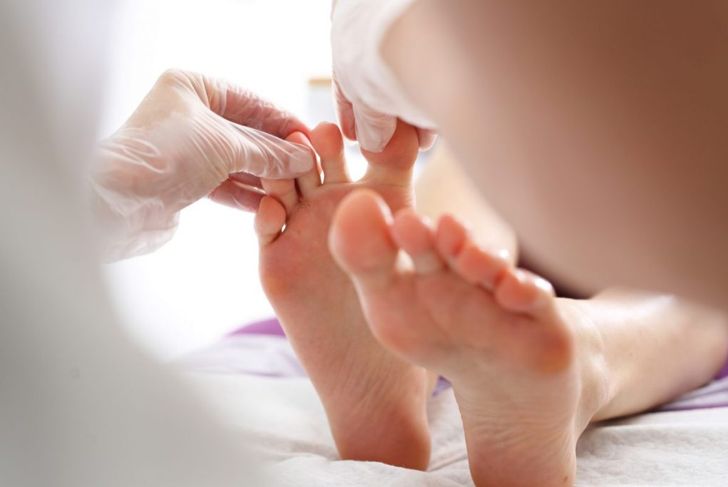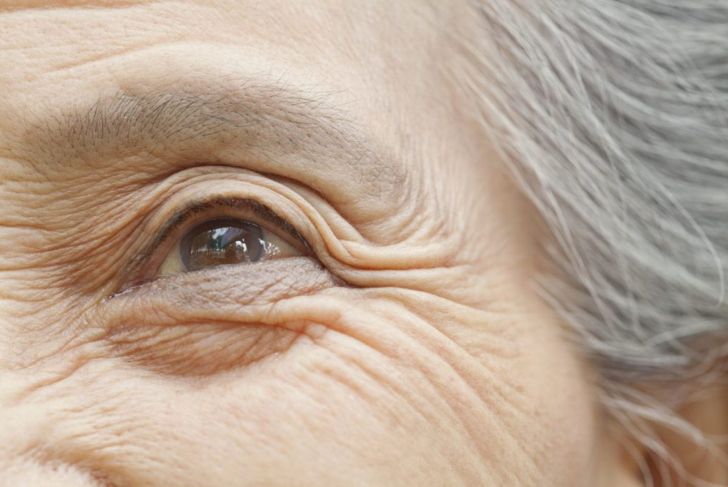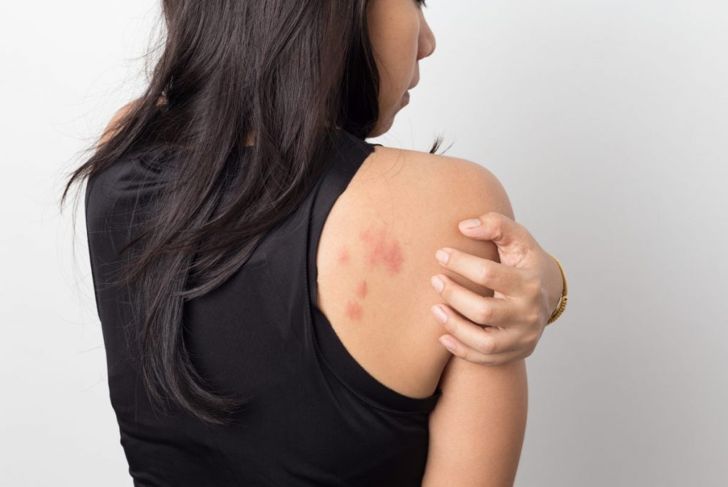For decades, medical communities have warned people about the dangers of too much sun exposure. Unfortunately, suntanning and spending extended time outdoors without sunscreen continue to offer that socially acceptable “sun-kissed glow,” and doctors still diagnose more than five million new cases of non-melanoma skin cancer each year.People of any age can get skin cancer, and the signs are more widespread than just a mole or suspicious spot in an obvious place. Skin cancer can develop on the bottoms of the feet, in the genital area, and under the fingernails, too. In addition to monthly self-exams to help keep you aware of any new marks or bumps, understanding the signs and symptoms of the different types of skin cancer, and reaching out to a doctor if you’re concerned, help ensure quick diagnosis and early treatment if a condition does develop.
Bumps or Lesions
A pink, white, or skin-colored bump or lesion that appears on the face, ears, or neck may be a sign of basal cell carcinoma. The lesion can have a waxy appearance or be flat, red, and scaly. Some become irritated, bleed, and then scab over, and they may itch or hurt.This type of skin cancer begins in the basal cells, which are responsible for creating new skin cells after the old ones die. Less severe than melanoma, basal cell carcinomas seldom spread to vital organs, but they can cause nerve or muscle injury and disfigurement if not treated. About eight out of ten skin cancers are of the basal cell type.
Open Sores and Growths
A persistent red sore, nodule, or scaly patch on the body might indicate squamous cell carcinoma. The growths have a crusty exterior and often appear in areas that experience frequent sun exposure. They can also develop on top of old scars or ulcers.Squamous cell carcinoma can develop on any area of the body, including the genitals or inside of the mouth, though the most likely places are those sun-exposed areas: a balding scalp, or the neck, hands, arms, or face. They may also appear on the rim of the ear or the lower lip. Over the last three decades, the number of squamous cell carcinoma diagnoses has increased by more than 200%.
Asymmetrical Moles
Asymetrical moles with irregular borders can be a symptom of melanoma. Though not the most common type of skin cancer, melanoma is the most serious. It not only affects the skin, but can also affect the eyes, the palms of the hands, and the fingernail beds. Women often develop melanomas on the lower legs, while men tend to see them on the chest, back, head, and neck.Moles that change in size, color, or shape can indicate skin cancer. A mole that bleeds, itches, or changes in any way needs evaluation to rule out melanoma. A normal mole is about a ¼-inch in diameter, the size of a pea. Moles that grow larger warrant medical investigation. Doctors are seeing many more cases of this type of skin cancer in people under 40.
New Moles
Moles are a concentration of melanocytes or pigment-producing cells on the skin. Most are benign, with colors ranging from dark brown to shades of pink. The average adult has between ten and 45 moles on their body, most of which develop before the age of 50. People who habe more than 100 moles are at greater risk for melanoma.It is important not to ignore new moles that appear on adult skin because they are more likely to be cancerous. A new growth or lesion that isn’t a mole may also be a sign of skin cancer. These types of growths could also be precancerous lesions that have an increased risk of becoming cancerous in time.
Pigmented Patches, Domes, or Bumps
The most common sign of skin cancer is a change on the skin. A new patch resembling a mole may not be a mole at all, but a melanoma. The edges of a problematic patch will likely be less defined and appear more ragged. The coloring may be uneven, usually in varying shades of brown, tan, white, black, or blue.Normal moles are mostly symmetrical, while skin cancer patches are asymmetrical. Check existing moles regularly for changes, especially if you have a skin type more at risk for skin cancer, and do monthly skin exams to look for new marks. While it’s not necessary to panic at every new spot, some people find it helpful to record the size and shape of potentially problematic marks so it’s easier to track any changes over time.
Dark Spot on Palms or Soles of Feet
Acral lentiginous melanoma (ALM) is a type of cancer that develops on the palms of the hands, nail beds, and soles of the feet. This melanoma is darker than the skin around it and starts out as a small spot that looks like a bruise or stain. It may be tan, gray, brown, or black. Occasionally, they are red or orange, but the border around the spot is usually clearly defined.Researchers believe this type of melanoma skin cancer is genetic and not related to sun exposure. Acral lentiginous melanoma is more common in people of African and Asian descent. It often goes unnoticed or misdiagnosed, but ALM is more aggressive than other forms of melanoma, and prompt diagnosis and treatment is essential.
Streaks or Bruises in the Fingernails or Toenails
ALM can also develop as subungual melanomas under the fingernails or toenails. An early sign of this type of cancer is a dark stripe under the nail, usually the big toe or the thumb. Though this discoloration looks similar to what might appear if you dropped something heavy on the nail or caught it in a door, if it appears without this accident, it’s worth speaking to a doctor.As the streak grows, the nail may crack or break. Doctors may misdiagnose the condition as a fungal infection or a trauma injury, delaying accurate identification. Interestingly, the streaks that appear under the fingernail or toenail of people with darker skin are usually benign but should still be evaluated.
A Lump or Sore on the Vulva
The vulva is part of female genitalia. It includes the opening of the vagina, the inner and outer lips, and the clitoris. Two types of melanomas can develop on the vulva: cutaneous, which is usually on the outer labia, and mucosal, which starts in the inner parts of the vulva and its lips, near the vaginal entrance. It also may develop on the clitoris.Vulva melanomas make up less than two percent of the total number of melanomas in women. They may appear as a lump, but many of them first appear in an existing mole. The melanoma may be a dark brown or black spot on the skin, but some are pink, red, or white. Though this could be the only sign in the early stages, some women also experience pain, itching, or discharge.
Bumps on the Eyelid
The eyelid is made up of extremely thin skin and is therefore especially vulnerable to the harmful UV rays of the sun. Between five and ten percent of all skin cancers develop on the eyelids, with the majority occurring on the lower lid. Most are basal cell carcinomas, which are slow-growing. Squamous cell cancers, malignant melanomas, and sebaceous gland carcinomas can also begin in the eye area but are less common.Smooth, shiny bumps that are firm or red are a symptom of this type of skin cancer and should be investigated by a doctor immediately. Styes, nodules, swelling of the eyelid, or lesions that grow, bleed, or do not heal can also indicate the disease. In some cases, the person will find that their eyelashes begin to fall out.
Symptoms of Less Common Skin Cancers
Some forms of skin cancer are rare but no less detrimental. Purple or red patches on the skin or in the mucous membranes may be a symptom of Kaposi sarcoma, a type of cancer that develops in cells that line the blood or lymph vessels. People with weakened immune systems, such as those with HIV, are more susceptible to this type of cancer.Firm, shiny, flesh-colored, or bluish-red nodules that develop at the hair follicles and below the surface of the skin on the neck, head, and body are symptoms of Merkel cell carcinoma (MCC). Physicians diagnose about 2,000 cases each year, most of which are in men over the age of 70.

 Home
Home Health
Health Diet & Nutrition
Diet & Nutrition Living Well
Living Well More
More